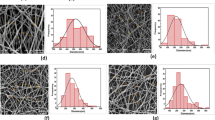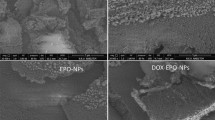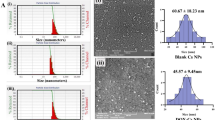Abstract
Aim:
To investigate the in vitro release profile of drugs encapsulated within perfluorocarbon (PFC) nanoparticles (NPs) and their ability to inhibit the activity of vascular smooth muscle cells (SMCs).
Methods:
Dexamethasone phosphate (DxP) or dexamethasone acetate (DxA) was encapsulated into PFC nanoparticles using a high-pressure homogenous method. The morphology and size of the NPs were examined using scanning electron microscopy (SEM) and a laser particle size analyzer. Drug loading and in vitro release were assessed by high-performance liquid chromatography (HPLC). The impact of NP capsules on SMC proliferation, migration and apoptosis in vitro was assessed using cell counting kit-8, transwell cell migration and flow cytometry assays.
Results:
The sizes of DxP-NPs and DxA-NPs were 224±6 nm and 236±9 nm, respectively. The encapsulation efficiency (EE) of DxP-NPs was 66.4%±1.0%, with an initial release rate of 77.2%, whereas the EE of DxA-NPs was 95.3%±1.3%, with an initial release rate of 23.6%. Both of the NP-coated drugs could be released over 7 d. Human umbilical artery SMCs were harvested and cultured for four to six passages. Compared to free DxP, SMCs treated with tissue factor (TF)-directed DxP-NPs showed significant differences in the inhibition of proliferation, migration and apoptosis (P<0.05).
Conclusion:
The results collectively suggest that PFC nanoparticles will be beneficial for targeted drug delivery because of the sustained drug release and effective inhibition of SMC proliferation and migration.
Similar content being viewed by others
Log in or create a free account to read this content
Gain free access to this article, as well as selected content from this journal and more on nature.com
or
References
Schainfeld RM . Potential emerging therapeutic strategies to prevent restenosis in the peripheral vasculature. Catheter Cardiovasc Interv 2002; 56: 421–31.
Shah PB, Lilly CM . Interventional therapy for coronary artery disease. Am J Respir Crit Care Med 2002; 166: 791–6.
Costa MA, Simon DI . Molecular basis of restenosis and drug-eluting stents. Circulation 2005; 111: 2257–73.
Kolodgie FD, John M, Khurana C, Farb A, Wilson PS, et al. Sustained reduction of instent neointimal growth with the use of a novel systemic nanoparticle paclitaxel. Circulation 2002; 106: 1195–8.
Dibra A, Kastrati A, Mehilli J, Pache J, Schühlen H, et al. Paclitaxel-eluting or sirolimus-eluting stents to prevent restenosis in diabetic patients. N Engl J Med 2005; 353: 663–70.
Jaschke B, Michaelis C, Milz S, Vogeser M, Mund T, et al. Local statin therapy differentially interferes with smooth muscle and endothelial cell proliferation and reduces neointima on a drug-eluting stent platform. Cardiovasc Res 2005; 68: 483–92.
Patti G, Pasceri V, Carminati P, D'Ambrosio A, Carcagnì A, Di Sciascio G . Effect of dexamethasone-eluting stents on systemic inflammatory response in patients with unstable angina pectoris or recent myocardial infarction undergoing percutaneous coronary intervention. Am J Cardiol 2005; 95: 502–5.
Joner M, Finn AV, Farb A, Mont EK, Kolodgie FD, Ladich E, et al. Pathology of drug-eluting stents in humans: delayed healing and late thrombotic risk. J Am Coll Cardiol 2006; 48: 193–202.
Harald Vik-Mo, Rune W, Knut H . Coronary aneurysm after implantation of a paclitaxel-eluting stent. Scandinavian Cardiovasc J 2004; 38: 349–52.
Sarker DK . Engineering of nanoemulsions for drug delivery. Curr Drug Deliv 2: 297–310.
Lanza GM, Winter P, Caruthers S, Schmeider A, Crowder K, Morawski A, et al. Novel paramagnetic pontrast agents for molecular imaging and targeted drug delivery. Curr Pharm Biotechnol 2004; 5: 495–507.
Lanza GM, Yu X, Winter PM, Abendschein DR, Karukstis KK, Scott MJ, et al. Targeted antiproliferative drug delivery to vascular smooth muscle cells with a magnetic resonance imaging nanoparticle contrast agent: Implications for rational therapy of restenosis. Circulation 2002; 106: 284–27.
Dong YC, Feng SS . Methoxy poly (ethylene glycol)-poly(lactide) (MPEG-PLA) nanoparticles for controlled delivery of anticancer drugs. Biomaterials 2004; 25: 284–39.
Gallicchio M, Argyriou S, Ianches G, Filonzi EL, Zoellner H, Hamilton JA, et al. Stimulation of PAI-1 expression in endothelial cells by cultured vascular smooth muscle cells. Arterioscler Thromb Vasc Biol 1994; 14: 815–23.
Cordelier P, Esteve JP, Rivard N, Marletta M, Vaysse N, Susini C, et al. The activation of neuronal NO synthase is mediated by G-protein βγ subunit and the tyrosine phosphatase SHP-2. FASEB 1999: 132037–50.
Chaulet H, Desgranges C, Renault MA, Dupuch F, Ezan G, Peiretti F, et al. Extracellular nucleotides induce arterial smooth muscle cell migration via osteopontin. Circ Res 2001; 89: 772–8.
Mayr M, Li C, Zou Y, Huemer U, Hu Y, Xu Q . Biomechanical stress-induced apoptosis in vein grafts involves p38 mitogen-activated protein kinases. FASEB 2000; 14: 261–70.
Wickline SA, Lanza GM . Nanotechnology for molecular imaging and targeted therapy. Circulation 2003; 107: 109–25.
Winter PM, Schmieder AH, Caruthers SD, Keene JL, Zhang H, Wickline SA, et al. Minute dosages of vβ3-targeted fumagillin nanoparticles impair Vx-2 tumor angiogenesis and development in rabbits. FASEB 2008; 22: 2758–67.
Nihant N, Grandfiles C, Jerome R, Teyssie P . Microencapsulation by coacervation of poly (lactid-co-glycolide), IV: effect of the processing parameters on coacervation and encapsulation. J Control Release 1995; 35: 117–25.
Song CX, Labhasetwar V, Cui XM, Underwood T, Levy RJ . Arterial uptake of biodegradable nanoparticles for intravascular local drug delivery: Results with an acute dog model. J Control Release 1998; 54: 201–11.
Guzman LA, Labhasetwar V, Song CX, Jang YS, Lincoff AM, Levy R, et al. Local intraluminal infusion of biodegradable polymeric nanoparticles. A novel approach for prolonged drug delivery after balloon angioplasty. Circulation 1996; 94: 1441–18.
Lanza GM, Abendschein DR, Hall CS, Marsh JN, Scott MJ, Scherrer DE, et al. Molecular imaging of stretch induced tissue factor expression in carotid arteries with intravascular ultrasound. Invest Radiol 2000; 35: 227–34.
Huang ZR, Hua SC, Yang YL, Fang JY . Development and evaluation of lipid nanoparticles for camptothecin deliver: a comparison of solid lipid nanoparticles, nanostructured lipid carriers, and lipid emulsion. Acta Pharmacol Sin 2008; 29: 1094–102.
Kima J, Chauhan A . Dexamethasone transport and ocular delivery from poly(hydroxyethyl methacrylate) gels. Int J Pharm 2008; 2: 205–22.
Kim Dong-Hwan, Martin DC . Sustained release of dexamethasone from hydrophilic matrices using PLGA nanoparticles for neural drug delivery. Biomaterial 2006; 27: 303–17.
Zweersa LT, Engbersa HM, Grijpmaa DW, Feijen J . Release of anti-restenosis drugs from poly(ethylene oxide)-poly(dl-lactic-co-glycolic acid) nanoparticles. J Control Release 2006; 114: 317–24.
Cleek RL, Rege AA, Denner LA, Eskin SG, Mikos AG . Inhibition of smooth muscle cell growth in vitro by an antisense oligodeoxynucleotide released from poly (DL-lactic-co-glycolic acid) microparticles. J Biomed Mater Res 1998; 35: 525–30.
Isner JM, Kearney M, Bortman S, Passeri J . Apoptosis in human atherosclerosis and restenosis. Circulation 1995; 91: 2703–11.
Acknowledgements
This work is supported by the Science and Technology Commission of Shanghai Municipality, China (0852nm05100). The authors wish to thank Professor Jennifer GAMBLE for critical review of the manuscript. We also thank the Central Research Institute of Shanghai Pharmaceutical (Group) Co for providing the high-pressure homogenizer.
Author information
Authors and Affiliations
Corresponding author
Rights and permissions
About this article
Cite this article
Zhou, Zx., Zhang, Bg., Zhang, H. et al. Drug packaging and delivery using perfluorocarbon nanoparticles for targeted inhibition of vascular smooth muscle cells. Acta Pharmacol Sin 30, 1577–1584 (2009). https://doi.org/10.1038/aps.2009.146
Received:
Accepted:
Published:
Issue date:
DOI: https://doi.org/10.1038/aps.2009.146



